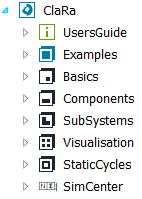Library Structure
Created Wednesday 12 June 2013
Creating a library covering a very broad range of physics that is at the same time well-arranged and user friendly, demands an elaborate library structure. The figure below shows the top level content of the ClaRa library.

The package A User Guide provides introductory material about the library and its usage. As the library is continuously updated and improved.
The package Examples provides models at different stages of complexity. It is intended not only for demonstration of the library capabilities.
The package SubSystems provide models of increasing complexity and are based on each other, as indicated by the little black boxes in the icons.
The package Basics provides elements which are fundamental to all models contained in ClaRa. Beside data structures (Records/Types/Choices), special Functions and Constants the package provides Interface (connector-) definitions, Media data, the ClaRa unit system (based on SI units) and the fundamental Control Volume definitions.

The package Components provides all basic models necessary in order to build up models for conventional power plants. The package is divided into sub-packages according to the different component categories, e.g. TurboMachines, VolumeValvesFittings or Furnace.

The package Visualisation contains various elements for displaying and plotting of dynamic simulation data. By watching the diagram layer of a model in simulation mode this is already possible at run time of the simulation. Quadruples for example provide a dynamic version of similar displays used in steady state simulators or manufacturer design sheets of components.
The package StaticCycles enables the user to initialise complex models in an effective systematic way. The package contains simplified versions of almost all dynamic models in ClaRa. These can be used in order to assemble a simplified duplicate of the dynamic model to be simulated. Taking as user input only a human-accessible set of preferred start up values, the StaticCycle model then computes a complete set of consistent initialisation values at simulation start up. These initialisation values are then passed on to the dynamic model.
Finally, SimCenter is a top level model which is mandatory for every complex ClaRa simulation. It provides global settings such as the media models used by all sub-models or if flow reversal shall be allowed.
Additional information on the modelling ideas behind the ClaRa can be found in Basic Concepts of Modelling while SubSystems gives some advice to ease the collaboration in teams and help to structure your ClaRa power plant models. Please note that there is also a little package named subsystems in the ClaRa which has currently only little content but may be enhanced in the future.
